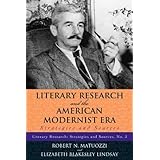
Average Reviews:

(More customer reviews)Robert Matuozzi (Humanities Bibliographer in English and American Literature) and Elizabeth Lindsay (Assistant Dean for Public Services) at the Washington State University Library are commended for going where few Ph.D.-level English professors dare to go -- to write a thorough research guide to a genre of American Literature.
The first chapter is a step-by-step instructional guide on how to break search questions into key words and descriptors that can be searched as Boolian "and", "or" and "not" operators or truncated in such databases as MLA International Bibliography (MLAIB), the Annual Bibliography of English Language Literature (ABELL), and World Cat.
Chapter 2 describes general literary research guides and companions, period-specific encyclopedias and companions, biographical sources, chronologies, and examples of selected individual author sources. Examples for this section are resources related to: Zora Neale Hurston, F. Scott Fitzgerald, T.S. Eliot, William Faulkner, John Dos Passos, Ezra Pound, and Gertrude Stein and Alice B. Tokalas.
Chapter 3 is devoted to institution-specific, regional and world-wide online public access catalogs (OPACs). They sidestep discussion of product-specific vendor software and focus instead on the generalities all such catalogs share. Delving first into standard "Author," "Title" and "Subject" searching, the authors then describe examples of National Library catalogs, the Pre-1956 "National Union Catalog", and the "World Cat" and "Open World Cat" electronic databases.
Chapter 4 is more along the lines of what English professors will feel comfortable with -- descriptions of print and electronic bibliographies, indexes and annual reviews that are -- more often than not -- electronic versions of print sources they would have used in graduate school in years past, including: MLAIB, ABELL, and H.W. Wilson's "Humanities Index" and "Humanities and Social Science Index Retrospective." These are followed by descriptions of other standard American Literature Bibliographies (e.g. Yale's "Bibliography of American Literature" etc.), bibliographies on Modernism, genre bibliographies, annual reviews, and -- using many of the previously mentioned authors as examples -- "Modernist Author Bibliographies."
Chapter 5 is an annotated descriptive bibliography of scholarly journals of the Modernist era and "General Twentieth-Century and American Literature Journals."
In Chapter 6, the authors focus on how students can identify and locate book reviews, literary criticism, and author-specific bibliographies. Again, some of the same authors previously mentioned are used as examples.
Chapters 7, 8 and 9 are devoted to: helping students locate useful information in newspapers and periodicals that "attained wider circulation in American households" during this period; identify useful archival collections and work with primary source materials; and, how to best utilize the Web for e-mail lists, bulletin boards, open-access journals, and author-specific Web sites.
Matuozzi and Lindsay close with a chapter titled "Researching a Thorny Problem," to illustrate how one might go about researching the life and works of Nella Larsen, a key figure of the Harlem Renaissance; and, an Appendix that serves as a brief, annotated descriptive bibliography of sources in related disciplines that might be of assistance to literary scholars of the American Moderist Era.
While I would have liked to have seen more author-specific examples and a uniform use of these same authors of the period throughout the text, I also recognize that doing so would have made the book much longer and nearly impossible to complete. As such, this easy-to-use, step-by-step guide is not nearly as intimidating as one that might follow my criticism -- thus, the authors are commended for keeping it relatively, short,straight-forward and easy-to-use.
This is a book that many libraries are going to want to buy multiple copies of -- one for the Reference collection, another for students to check out, and yet another for the English Bibliographer or Library Instruction Librarian to have on their bookshelf to grab on the way to BI sessions for upper-level American Literature classes and/or graduate Bibliography classes.
Destined to spend many years listed on upper-level and graduate bibliography class syllabi, this guide is highly recommended for all college and university libraries.
R. Neil Scott
Middle Tennessee State University
Click Here to see more reviews about: Literary Research and the American Modernist Era: Strategies and Sources (Literary Research: Strategies and Sources)
Characterized by its move away from Romanticism and toward mundane, every day subjects, as well as incorporating such ideas as metanarrative, stream of consciousness, and disjointed timelines, the American Modernist Era was at its heyday during the years 1914-1949. It produced such great authors as Ernest Hemingway, William Faulkner, and F. Scott Fitzgerald, and memorable works like As I Lay Dying and The Great Gatsby.Literary Research and the American Modernist Era offers the scholar and researcher a clear introduction to the best contemporary library resources and practices for researching American modernist writing. Graduate students, advanced undergraduates, researchers, and scholars specializing in American modernist writing will improve their information skills and fluency, whether in the real or the virtual library. Even those lacking access to some of the resources described here can profit from this overview of literary research because it will help them frame questions, indicate where to go for answers, and demonstrate useful connections between many of the secondary scholarly sources. This guide offers a coherent account of how contemporary research skills and resources can complement one another in helping the scholar effectively deal with typical challenges they encounter in their work

0 comments:
Post a Comment